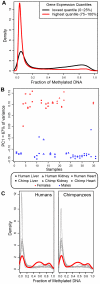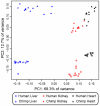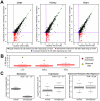A genome-wide study of DNA methylation patterns and gene expression levels in multiple human and chimpanzee tissues
- PMID: 21383968
- PMCID: PMC3044686
- DOI: 10.1371/journal.pgen.1001316
A genome-wide study of DNA methylation patterns and gene expression levels in multiple human and chimpanzee tissues
Abstract
The modification of DNA by methylation is an important epigenetic mechanism that affects the spatial and temporal regulation of gene expression. Methylation patterns have been described in many contexts within and across a range of species. However, the extent to which changes in methylation might underlie inter-species differences in gene regulation, in particular between humans and other primates, has not yet been studied. To this end, we studied DNA methylation patterns in livers, hearts, and kidneys from multiple humans and chimpanzees, using tissue samples for which genome-wide gene expression data were also available. Using the multi-species gene expression and methylation data for 7,723 genes, we were able to study the role of promoter DNA methylation in the evolution of gene regulation across tissues and species. We found that inter-tissue methylation patterns are often conserved between humans and chimpanzees. However, we also found a large number of gene expression differences between species that might be explained, at least in part, by corresponding differences in methylation levels. In particular, we estimate that, in the tissues we studied, inter-species differences in promoter methylation might underlie as much as 12%-18% of differences in gene expression levels between humans and chimpanzees.
Conflict of interest statement
The authors have declared that no competing interests exist.
Figures




Similar articles
-
A comparison of gene expression and DNA methylation patterns across tissues and species.Genome Res. 2020 Feb;30(2):250-262. doi: 10.1101/gr.254904.119. Epub 2020 Jan 17. Genome Res. 2020. PMID: 31953346 Free PMC article.
-
Divergent whole-genome methylation maps of human and chimpanzee brains reveal epigenetic basis of human regulatory evolution.Am J Hum Genet. 2012 Sep 7;91(3):455-65. doi: 10.1016/j.ajhg.2012.07.024. Epub 2012 Aug 23. Am J Hum Genet. 2012. PMID: 22922032 Free PMC article.
-
Estimation of chimpanzee age based on DNA methylation.Sci Rep. 2018 Jul 3;8(1):9998. doi: 10.1038/s41598-018-28318-9. Sci Rep. 2018. PMID: 29968770 Free PMC article.
-
Comparative primate genomics: the year of the chimpanzee.Curr Opin Genet Dev. 2004 Dec;14(6):650-6. doi: 10.1016/j.gde.2004.08.007. Curr Opin Genet Dev. 2004. PMID: 15531160 Review.
-
Differences between human and chimpanzee genomes and their implications in gene expression, protein functions and biochemical properties of the two species.BMC Genomics. 2020 Sep 10;21(Suppl 7):535. doi: 10.1186/s12864-020-06962-8. BMC Genomics. 2020. PMID: 32912141 Free PMC article. Review.
Cited by
-
Cross-Species Comparative DNA Methylation Reveals Novel Insights into Complex Trait Genetics among Cattle, Sheep, and Goats.Mol Biol Evol. 2024 Feb 1;41(2):msae003. doi: 10.1093/molbev/msae003. Mol Biol Evol. 2024. PMID: 38266195 Free PMC article.
-
The relationship between regulatory changes in cis and trans and the evolution of gene expression in humans and chimpanzees.Genome Biol. 2023 Sep 11;24(1):207. doi: 10.1186/s13059-023-03019-3. Genome Biol. 2023. PMID: 37697401 Free PMC article.
-
The contribution of DNA methylation to the (dys)function of oligodendroglia in neurodegeneration.Acta Neuropathol Commun. 2023 Jun 29;11(1):106. doi: 10.1186/s40478-023-01607-9. Acta Neuropathol Commun. 2023. PMID: 37386505 Free PMC article. Review.
-
Comparative analysis reveals epigenomic evolution related to species traits and genomic imprinting in mammals.Innovation (Camb). 2023 Apr 28;4(3):100434. doi: 10.1016/j.xinn.2023.100434. eCollection 2023 May 15. Innovation (Camb). 2023. PMID: 37215528 Free PMC article.
-
Brain DNA methylomic analysis of frontotemporal lobar degeneration reveals OTUD4 in shared dysregulated signatures across pathological subtypes.Acta Neuropathol. 2023 Jul;146(1):77-95. doi: 10.1007/s00401-023-02583-z. Epub 2023 May 7. Acta Neuropathol. 2023. PMID: 37149835 Free PMC article.
References
-
- King M-C, Wilson AC. Evolution at Two Levels in Humans and Chimpanzees. Science. 1975;188:107–116. - PubMed
-
- Britten RJ, Davidson EH. Gene Regulation for Higher Cells: A Theory. Science. 1969:349–357. - PubMed
-
- Enard W, Khaitovich P, Klose J, Zöllner S, Heissig F, et al. Intra- and interspecific variation in primate gene expression patterns. Science. 2002;296:340–343. - PubMed
-
- Khaitovich P, Hellmann I, Enard W, Nowick K, Leinweber M, et al. Parallel patterns of evolution in the genomes and transcriptomes of humans and chimpanzees. Science. 2005;309:1850–1854. - PubMed
Publication types
MeSH terms
Grants and funding
LinkOut - more resources
Full Text Sources
Other Literature Sources

